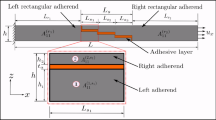Abstract
A fracture-mechanics approach has been used to predict the cyclic-fatigue performance of the adhesively-bonded single-lap joint and a typical bonded component, represented by an adhesively-bonded `top-hat' box-beam joint. The joints were tested under cyclic-fatigue loading in either a `wet' or `dry' environment, respectively. Several steps were needed to predict the cyclic-fatigue lifetime of these joints. Firstly, fracture-mechanics tests were used to obtain the relationship between the rate of fatigue crack growth per cycle, da/dN, and the maximum strain-energy release-rate, G max, applied during the fatigue cycle for the adhesive/substrate system under investigation, in both a `dry' and a `wet' test environment. Secondly, analytical and finite-element theoretical models were developed to describe the variation of the strain-energy release-rate with crack length, as a function of the applied fatigue loads, for the single-lap joint and the `top-hat' box-beam joint. Thirdly, the experimental results from the short-term fracture-mechanics tests, obtained under similar test conditions and in the same environment as were used for the single-lap or bonded box-beam joints, were combined with the modelling results from the theoretical studies. This enabled the cyclic-fatigue performance of the single-lap or bonded box-beam joints to be predicted over relatively long time-periods. Finally, the agreement between the theoretical predictions and the experimentally-measured cyclic-fatigue behaviour for the joints was found to be very good.
Similar content being viewed by others
References
ABAQUS User's Manual, Version 5.6, Hibbit, Karlsson & Sorenson Inc., USA (1996).
Adams, R.D. and Peppiatt, N. (1973). Effect of Poisson's ratio strains in adherends on stresses of an idealized lap joint. Journal of Strain Analysis 8 (2), 134–139.
American Society for Testing and Materials (1983). Standard test method for strength properties of adhesives in shear by tension loading (metal-to-metal). ASTM D1002.
Bishopp, J.A. and Thompson, G.E. (1993). The role of electron microscopy in the study of adhesion to aluminium substrates. Surface and Interface Analysis 20, 485–494.
Curley, A.J., Jethwa, J.K., Kinloch, A.J. and Taylor, A.C. (1998). The fatigue and durability behaviour of automotive adhesives. Part III: Predicting the service life. Journal of Adhesion 66, 39–59.
Dean, G.D. and Duncan, B.C. (1995). Tensile behaviour of bulk specimens of adhesives. Report 1.3, Measurement Technology and Standards Programme on the Performance of Adhesive Joints. Department of Trade and Industry, UK.
Dickie, R.A., Haack, L.P., Jethwa, J.K., Kinloch, A.J. and Watts, J.F. (1997). The fatigue and durability behaviour of automotive adhesives. Part II: Failure mechanisms. Journal of Adhesion 66, 1–37.
Fernando, M., Harjoprayitno, W.W. and Kinloch, A.J. (1996). A fracture mechanics study of the influence of moisture on the fatigue behaviour of adhesively-bonded aluminium-alloy joints. International Journal of Adhesion and Adhesives 16(2), 113–119.
Hart-Smith, L.J. (1985). Designing to minimize peel stresses in adhesive-bonded joints. ASTM STP 876, 238–266.
Imanaka, M., Haraga, K. and Nishikawa, T. (1995). Fatigue strength of adhesive/rivet combined lap joints. Journal of Adhesion 49, 197–209.
Jethwa, J.K. and Kinloch, A.J. (1997). The fatigue and durability behaviour of automotive adhesives. Part I: Fracture mechanics tests. Journal of Adhesion 61, 71–95.
Johnson, W.S. and Mall, S. (1985). A fracture mechanics approach for designing adhesively bonded joints. ASTM STP 876, 189–199.
Kinloch, A.J. (1987). Adhesion and adhesives: Science and technology. Chapman and Hall, London.
Kinloch, A.J. and Osiyemi, S.O. (1993). Predicting the fatigue life of adhesively-bonded joints. Journal of Adhesion 43, 79–90.
Kinloch, A.J., Shaw, S.J., Tod, D.A. and Hunston, D.L. (1983). Deformation and fracture behaviour of a rubbertoughened epoxy: 1. Microstructure and fracture studies. Polymer 24, 1341–1354.
Mall, S. and Kochhar, N.K. (1988). Characterization of debond growth mechanism in adhesively bonded composites under mode II static and fatigue loadings. Engineering Fracture Mechanics 31, 747–758.
Martin, R.H. and Murri, G.B. (1990). Characterization of mode I and mode II delamination growth and thresholds in AS4/PEEK composites. ASTM STP 1057, 251–270.
Mostovoy, S. and Ripling, E.J. (1966). Fracture toughness of an epoxy system. Journal of Applied Polymer Science 10, 1351–1371.
Paris, P.C. and Erdogan, F. (1963). A critical analysis of crack propagation laws. Journal of Basic Engineering 85(4), 528–534.
Rice, J.R. (1968). A path-independent integral and the approximate analysis of strain concentration by notches and cracks. Journal of Applied Mechanics 35, 379–386.
Rybicki, E.F. and Kanninen, M.F. (1977). A finite element calculation of stress intensity factors by a modified crack closure integral. Engineering Fracture Mechanics 9, 931–938.
Smelser, R.E. and Gurtin, M.E. (1977). On the J-integral for bi-material bodies. International Journal of Fracture 13, 382–384.
Taylor, A.C. (1997). The impact and durability behaviour of adhesively-bonded metal joints. Ph.D. Thesis, University of London.
Venkatesha, K.S., Dattaguru, B. and Ramamurthy, T.S. (1996). Finite element analysis of an interface crack with large crack-tip contact zones. Engineering Fracture Mechanics 54, 847–860.
Wang, S.S. and Yau, J.F. (1982). Interface cracks in adhesively bonded lap-shear joints. International Journal of Fracture 19, 295–309.
Williams, J.G. (1988). On the calculation of energy release rates for cracked laminates. International Journal of Fracture 36, 101–119.
Williams, M.L. (1959). The stresses around a fault or crack in dissimilar media. Bull. Seism. Soc. Am., 49, 199–204.
Zhang, Z., Shang, J.K. and Lawrence, F.V., Jr. (1995). A backface strain technique for detecting fatigue crack initiation in adhesive joints. Journal of Adhesion 49, 23–36.
Zhao, X., Adams, R.D. and Pavier, M.J. (1990). A new approach to determining the bending moment factors in single lap joints. In Proceedings of Adhesion '90, Plastics and Rubber Institute, London, 35-1–35-6.
Author information
Authors and Affiliations
Rights and permissions
About this article
Cite this article
Curley, A., Hadavinia, H., Kinloch, A. et al. Predicting the service-life of adhesively-bonded joints. International Journal of Fracture 103, 41–69 (2000). https://doi.org/10.1023/A:1007669219149
Issue Date:
DOI: https://doi.org/10.1023/A:1007669219149




